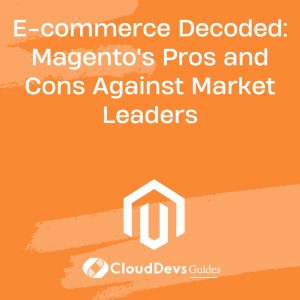E-commerce Platforms Decoded: Magento’s Pros and Cons Against Market Leaders
In the vast and varied world of e-commerce, choosing the right platform is crucial. It’s akin to selecting a location for a physical store; the platform you choose will impact visibility, growth potential, and the overall customer experience. Magento is a widely recognized platform in this sphere, but how does it stack up against others? This post will delve into Magento’s features and compare them with other notable e-commerce platforms.
Magento Overview
Strengths:
– Customizability: As an open-source platform, Magento offers unparalleled flexibility. Developers can tweak and adjust it to perfectly fit their needs.
– Scalability: Magento can handle massive product catalogs and is designed to scale with your business. This makes it suitable for both SMEs and larger enterprises.
– Extensions & Integrations: With its vast marketplace of plugins and integrations, extending Magento’s functionality is simple.
Weaknesses:
– Complexity: Due to its powerful features, there can be a steeper learning curve, especially for those without technical experience.
– Cost: While the community edition is free, the enterprise version can be pricey. Additionally, hosting and development costs can add up.
Comparison With Other Platforms
1. Magento vs. Shopify
Shopify Overview:
– Ease of Use: Shopify is known for its user-friendly interface, allowing beginners to set up stores swiftly.
– Pricing: With a monthly fee structure, you know what to expect in terms of costs.
– Themes: Shopify has a selection of professional themes that users can easily apply.
Comparison:
– Customizability: While Shopify offers a range of plugins, its closed source nature means it doesn’t match Magento’s flexibility.
– Cost: Shopify’s monthly fees can be more predictable than Magento’s variable costs, making budgeting easier for some businesses.
– User Friendliness: Shopify excels in providing a platform that’s easy to grasp, while Magento’s complexity can be daunting for new users.
2. Magento vs. WooCommerce
WooCommerce Overview:
– WordPress Integration: Being a WordPress plugin, WooCommerce integrates seamlessly with the CMS, making it ideal for businesses already using WordPress.
– Cost: It’s free, but certain extensions can carry costs.
– Customizability: Like Magento, it’s open-source, allowing for extensive customizations.
Comparison:
– Ease of Setup: WooCommerce might have a slight edge due to its WordPress integration, making it a natural choice for WordPress users.
– Scalability: Magento typically outperforms WooCommerce in terms of handling large stores and high traffic.
– Extensions: Both platforms offer extensive extensions, but Magento’s marketplace is more mature.
3. Magento vs. BigCommerce
BigCommerce Overview:
– SaaS Model: BigCommerce is a hosted platform, which means there’s no need to worry about hosting or security updates.
– Features: Out of the box, it comes with a range of e-commerce features.
– No Transaction Fees: Unlike some platforms, BigCommerce doesn’t charge transaction fees.
Comparison:
– Ease of Use: BigCommerce, being a SaaS platform, offers a smoother setup and user experience compared to Magento.
– Customizability: Magento’s open-source nature gives it an edge in terms of deep customizations.
– Cost: BigCommerce has clear pricing tiers, but as your business grows, you might find Magento’s community edition more cost-effective in the long run.
Conclusion
When choosing between Magento and other e-commerce platforms, it boils down to business needs. If you require extensive customization and scalability, Magento is tough to beat. However, for those looking for a simpler, more predictable platform, options like Shopify or BigCommerce might be more appealing.
For WordPress enthusiasts, WooCommerce offers a seamless e-commerce solution, though it might struggle with extremely large stores. Ultimately, understanding your business needs, technical expertise, and growth plans will guide you to the right platform. Whatever you choose, ensure it aligns with your long-term vision to maximize ROI and enhance customer satisfaction.
Table of Contents







